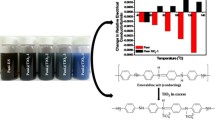Abstract
Polyaniline (PANI) and PANI/ZnCl2 composites were synthesized by chemical method and characterized by FTIR and SEM to confirm the formation of the composite. DC Current–Voltage and temperature-dependent electrical properties have been studied to explore the conduction mechanism. FTIR spectra of PANI showed all standard peaks and PANI/ZnCl2 sample showed peaks with a slight shift in wavelength position. SEM image of pure PANI illustrated as a cauliflower-like structure of around 20 μm whereas PANI/ZnCl2 confirms the encapsulation of ZnCl2 particles in the PANI matrix. The electrical conductivity of both the samples decreased concerning a decrease in temperature. Activation energy for both PANI (0.52 eV) and PANI/ZnCl2 (0.38 eV) composites was also calculated. Therefore, it is indicated that the presence of ZnCl2 in the PANI matrix reduces the activation energy. Hence, ZnCl2 doped PANI is best suitable for semiconductor device applications.







Similar content being viewed by others
REFERENCES
J. Wu, Y. Sun, W. B. Pei, L. Huang, W. Xu, and Q. Zhang, Synth. Met. 196, 173 (2014).
G. L. Schulz and S. Ludwigs, Adv. Funct. Mater. 27, 1603083 (2017).
C. Dingler, K. Dirnberger, and S. Ludwigs, Macromol. Rapid Commun. 40, 1800601 (2019).
Y. Wu, Y. Liu, T. Emrick, and T. P. Russell, Prog. Polym. Sci. 103, 101222 (2020).
I. Erukhimovich and M. O. de la Cruz, J. Polym. Sci., Part B: Polym. Phys. 45, 3003, (2007).
S. J. Tang, A.-T. Wang, S.-Y. Lin, K.-Y. Huang, C.‑C. Yang, J.-M. Yeh, and K.-C. Chiu, Polym. J. 43, 667 (2011).
K. G. Neoh, K. L. Tan, T. C. Tan, and E. T. Kang, J. Macromol. Sci., Part A: Pure Appl. Chem. 27, 347 (1990).
R. Karthikeyan, R. Sridhar, and R. Suresh, Int. J. Appl. Eng. Res. 13, 149 (2018).
S. Kalyane, Ind. J. Appl. Res. 3 (47), 341 (2013).
I. S. Ashwini, J. Pattar, P. Anjaneyulu, D. P. Babu, R. Sreekanth, S. R. Manohara, and M. Nagaraja, Synth. Met. 270, 116588 (2020).
M. Ajmal, M. U. Islam, and A. Ali, J. Supercond. Novel Magn. 31, 1375 (2018).
H. C. Pant, M. K. Patra, S. C. Negi, A. Bhatia, S. R. Vadera, and N. Kumar, Bull. Mater. Sci. 29, 379 (2006).
B. C. Kim, B. T. N. Ngoc, K. S. Yang, M. Kojima, Y. A. Kim, Y. J. Kim, M. Endo, and S. C. Yang, Adv. Mater. 19, 2341 (2007).
S. A. Awad and E. M Khalaf, J. Thermoplast. Comp. Mater. 1, 69 (2020).
J. Stezskal and R. G. Gilbert, Pure Appl. Chem. 74, 857 (2002).
Z. Zakaria, N. F. A. Halim, M. H. V. Schleusingen, A. K. M. S. Islam, U. Hashim, and M. N. Ahmad, J. Nanomater. 2015, 218204 (2015).
M. Trchová and J. Stejskal, Pure Appl. Chem. 83, 1803 (2011).
M. G. MacDiarmid, W. E. Jones, I. D. Norris, J. Gao, A. T. Johnson, N. J. Pinto Jr., J. Hone, B. Han, F. K. Ko, H. Okuzaki, and M. Llaguna, Synth. Met. 119, 27 (2001).
S. Vuillard, G. Louarn, and S. Lefrant, Phys. Rev. B: Condens. Matter Mater. Phys. 50, 496 (1994).
Z. Ping, J. Chem. Soc., Faraday Trans. 92, 3063 (2000).
O. P. Dimitriev, Polym. Bull. 50, 83 (2003).
J. Anand, P. S. Rao, S. Palaniappan, and D. N. Sathyanarayana, Synth. Met. 95, 57 (1998).
S. Shayegh, H. A. Bioki, M. B. Zarandi, N. K. Samani, and A. Rahnamanic, Polym. Sci., Ser. B 59, 616 (2017).
H. Liu, A. Pourret, and P. Guyot-sionnest, ACS Nano 4, 5211 (2010).
S. H. Carr, D. K. Davies, and P. Fischer, Electrical of Polymers Properties (Academic Press, Orlando, FL, 1982).
V. Luthra and A. Mansingh, Curr. Appl. Phys. 3, 219 (2003).
E. Riande and R. Diaz-Calleja, Electrical Properties of Polymers (Marcel Dekker, New York, 2004).
C. O. Yoon, M. Reghu, D. Moses, A. J. Heeger, Y. Cao, T.-A. Chen, X. Wu, and R. D. Rieke, Synth. Met. 75 (95), 229 (1995).
C. Yoon, M. Reghu, D. Mosesa, Y. Caob, and A. J. Heegerapb, Synth. Met. 69, 4 (1995).
J. Morita, T. Goto, S. Kanehashi, and T. Shimomura, Polymers 12, 2658 (2020).
Author information
Authors and Affiliations
Corresponding author
Ethics declarations
The authors declare that they have no conflict of interest.
Rights and permissions
About this article
Cite this article
Nagaraja, M., Geetha, T., Pattar, J. et al. Temperature-Dependent Studies on Electrical Properties of ZnCl2 Doped Polyaniline. Polym. Sci. Ser. B 63, 614–619 (2021). https://doi.org/10.1134/S1560090421050080
Received:
Revised:
Accepted:
Published:
Issue Date:
DOI: https://doi.org/10.1134/S1560090421050080




